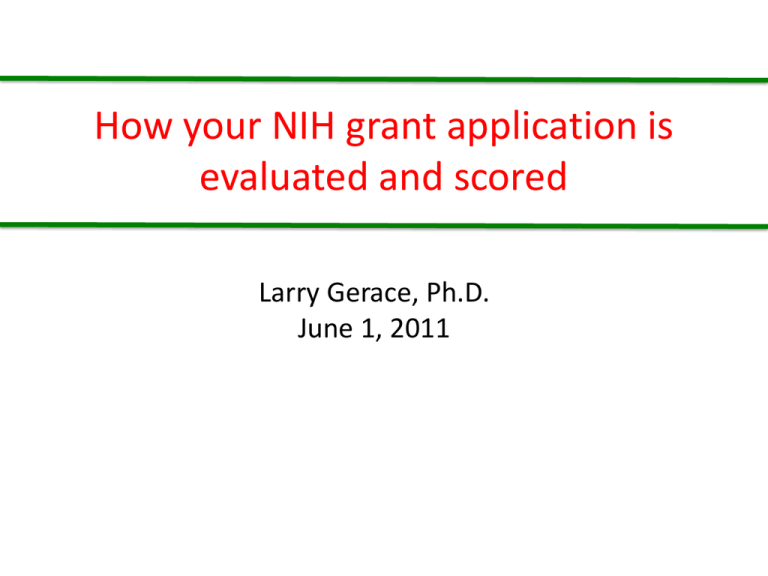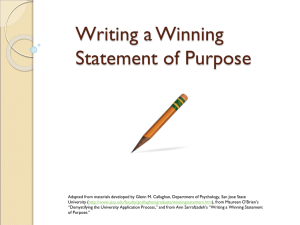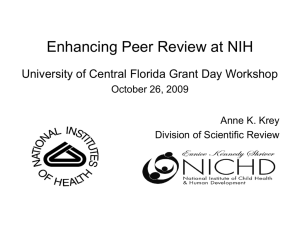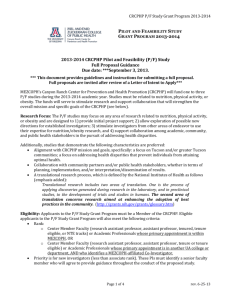Larry Gerace Presentation
advertisement

How your NIH grant application is evaluated and scored Larry Gerace, Ph.D. June 1, 2011 Tips for writing your first R01 application Read successful grant applications and summary statements from other PIs Follow the criteria stated in PHS-398 for the content of Specific Aims, Significance, Innovation, Approach Use models and/or data in “Background” and “Approach” to boost clarity and reviewers’ confidence Keep text from being too crowded; e.g., use spaces between sections Get feedback on your application from others before submitting (start early!) Scored review criteria for NIH grants Six criteria scored, each with a value of 1-9: • Overall Impact (“score”): Assessment of the likelihood for the project to exert a sustained, powerful influence on the research field(s) involved • Five Core Criteria (basis for “score”): 1) 2) 3) 4) 5) 3 Significance Investigator(s) Innovation Approach Environment Instructions to NIH grant reviewers for scoring: Score Descriptor Additional Guidance on Strengths/Weaknesses 1 2 3 4 5 6 7 8 9 Exceptional Outstanding Excellent Very Good Good Satisfactory Fair Marginal Poor Exceptionally strong with essentially no weaknesses Extremely strong with negligible weaknesses Very strong with only some minor weaknesses Strong but with numerous minor weaknesses Strong but with at least one moderate weakness Some strengths but also some moderate weaknesses Some strengths but with at least one major weakness A few strengths and a few major weaknesses Very few strengths and numerous major weaknesses Percentiles associated with scores and descriptors Impact High Impact Moderate Impact Low Impact Score Descriptor Strengths/Weaknesses 1 Exceptional Strengths 2 Outstanding 3 Excellent 4 Very Good 5 Good 6 Satisfactory 7 Fair 8 Marginal 9 Poor Weaknesses often ~15th percentile Portion of bullet point NIH review template Scoring in the core criteria 1) Significance • Is the application of major importance for advancing basic science and human health? • Is the work novel and does it have impact on both specific area and broader range of research topics? • Does the work address the question in a multidimensional manner; e.g. using multiple and/or interdisciplinary approaches? Scoring in the core criteria 2) Investigator(s) • Does the PI present a cogent Personal Statement in Biosketch on background and skills? • Is the PI’s track record indicative of success? • Is the impact of the work increased with collaborations that enhance depth? Scoring in the core criteria 3) Innovation • Does the work provide methodological advances or refinements and are these applicable to broader areas? • Does the work promise significant conceptual advances (changing general thinking about the problem)? • Does the work identify new pathways, mechanisms, etc. that “open up” major new research avenues? Scoring in the core criteria 4) Approach • Is the problem focused and go into sufficient depth to allow significant advances on key problems? (~3 Aims) • Can the work realistically be accomplished in 4/5 years? • Is rationale for each Aim provided? (introductory paragraph) • Are predicted outcomes and alternative approaches for sub-aims presented? (end of each sub-aim) • Is there preliminary data to justify feasibility of project? Scoring in the core criteria 5) Environment • Does the “local intellectual environment”, institution and neighboring institutions support a successful outcome? • Is the needed equipment available and accessible?











